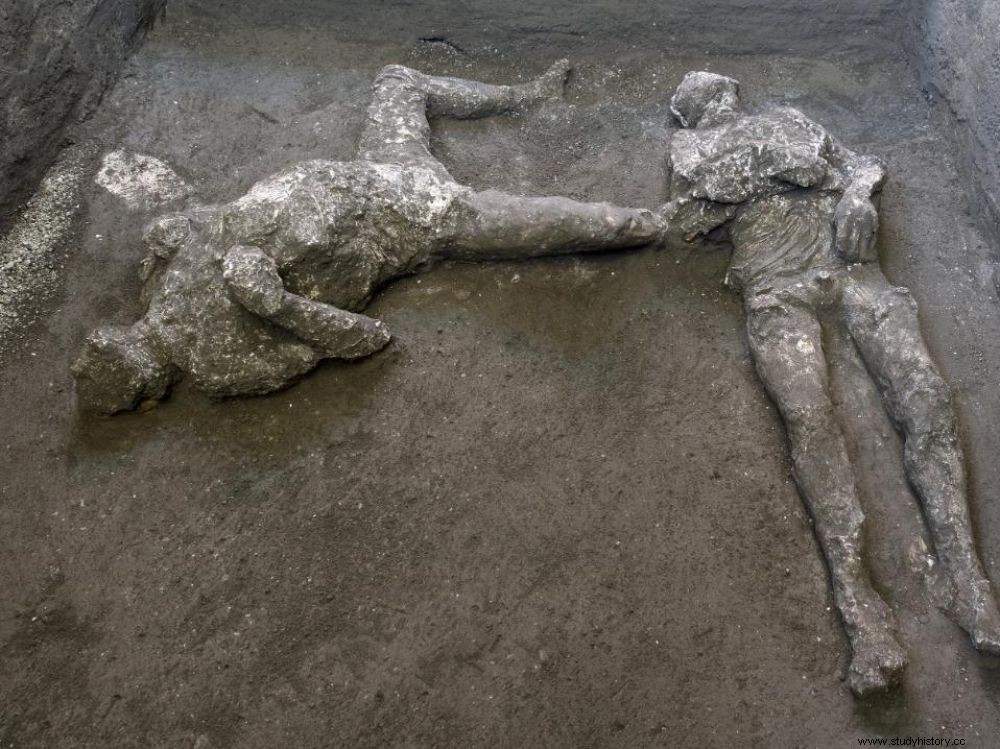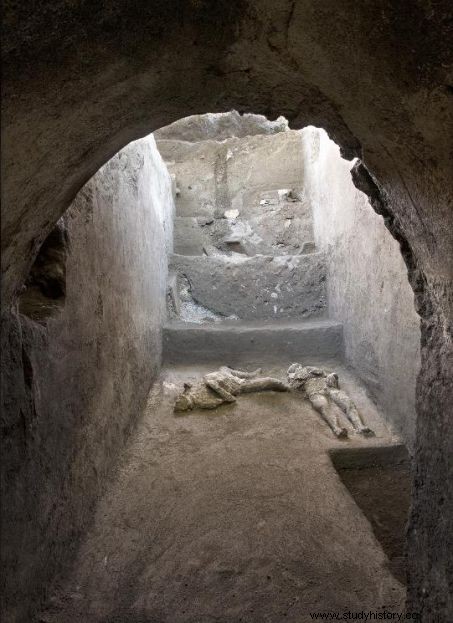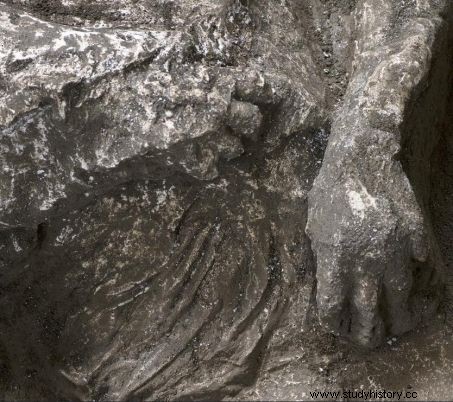Archaeologists have unearthed the exceptionally well-preserved remains of two men who died during the eruption of Vesuvius in 79 CE.

Remains of two men fleeing the volcanic eruption of Vesuvius nearly 2,000 years ago found in the ancient Roman city of Pompeii, Italy.
For nearly 2000 years, their agony had remained sequestered under the thick ashes of Pompeii. A press release from the Italian Ministry of Cultural Heritage has just announced that archaeological excavations have delivered the bodies of two new victims of the eruption of Vesuvius in 79 CE. Those possible of a master and his slave fleeing the disaster according to the researchers. These remains were found in a villa in the sector of Civita Giuliana , a prestigious property of the Augustan period located about 700 meters northwest of the site. “This is an exceptional find “, said Massimo Osanna, the director of the archaeological park of Pompeii, where excavations continue despite the pandemic.
New excavations undertaken in January 2020
On October 24 of this tragic year, the inhabitants of the small city of Campania so popular with the Roman aristocracy, found themselves submerged by phenomenal quantities of gas and debris, resulting from the eruption of the nearby volcano. Before the morning of the 25th, fiery pyroclastic clouds immured alive in a fluid and burning mass those who had not managed to flee, remained locked inside the dwellings. First works carried out in 2017 in the stables of this villa in the area of Civita Giuliana had already revealed the remains of three horses, one of which was harnessed and saddled, no doubt by people who were trying to flee.
And it was new excavations undertaken in January 2020 in the imposing residence that led to the discovery of these two men. “We were lucky , explained to the press Massimo Osanna. The location in which we found these bodies escaped both early 20th century excavations and grave robbers », the famous tombarolli who still roam the area. The use of the ingenious method of molding the location of the bodies caught in the compacted ashes revealed the position of the two men at the time of their dead. Conceived in the second half of the 19th century, this technique was perfected by Giuseppe Fiorelli (1823-1896), then inspector of the excavations of the city of Pompeii (read box ). Of the 1147 skeletons found since the discovery of Pompeii in the 18th century, 103 have been preserved in this form of casts.
For nearly 2000 years, their agony had remained sequestered under the thick ashes of Pompeii. A press release from the Italian Ministry of Cultural Heritage has just announced that archaeological excavations have delivered the bodies of two new victims of the eruption of Vesuvius in 79 CE. Those possible of a master and his slave fleeing the disaster according to the researchers. These remains were found in a villa in the sector of Civita Giuliana , a prestigious property of the Augustan period located about 700 meters northwest of the site. “This is an exceptional find “, said Massimo Osanna, the director of the archaeological park of Pompeii, where excavations continue despite the pandemic.
New excavations undertaken in January 2020
On October 24 of this tragic year, the inhabitants of the small city of Campania so popular with the Roman aristocracy, found themselves submerged by phenomenal quantities of gas and debris, resulting from the eruption of the nearby volcano. Before the morning of the 25th, fiery pyroclastic clouds immured alive in a fluid and burning mass those who had not managed to flee, remained locked inside the dwellings. First works carried out in 2017 in the stables of this villa in the area of Civita Giuliana had already revealed the remains of three horses, one of which was harnessed and saddled, no doubt by people who were trying to flee.
And it was new excavations undertaken in January 2020 in the imposing residence that led to the discovery of these two men. “We were lucky , explained to the press Massimo Osanna. The location in which we found these bodies escaped both excavations at the beginning of the XX th century and grave robbers », the famous tombarolli who still roam the area. The use of the ingenious method of molding the location of the bodies caught in the compacted ashes revealed the position of the two men at the time of their dead. Conceived in the second half of the 19th century, this technique was perfected by Giuseppe Fiorelli (1823-1896), then inspector of the excavations of the city of Pompeii (read box ). Of the 1147 skeletons found since the discovery of Pompeii in the 18 th century, 103 could thus be preserved in this form of casts.
 The underground room of the villa in the Civita Giuliana sector, in which the victims of the the eruption of Vesuvius in 79 CE. ©Arqueologico Park of Pompei.
The underground room of the villa in the Civita Giuliana sector, in which the victims of the the eruption of Vesuvius in 79 CE. ©Arqueologico Park of Pompei.
According to anthropologists from the Archaeological Park of Pompeii who were able to study the bone remains and teeth of the victims using endoscopes, the eldest of the two men was 30 to 40 years old. His body still bore marks of fabric fibers attributed to a woolen cape. On the upper part of the left arm, the imprint of a different textile could be that of a tunic. The second victim, aged 18 to 23, could be a slave. As proof, the state of his vertebrae, unusually tight for a boy of this age, could be linked to heavy work. The young man wore a short tunic cut in a heavy fabric - probably wool - whose imprint of the thick drapery is still visible on his stomach.
Already in 2018, the bodies of 2 women and 3 children had been discovered
The two victims were probably seeking refuge in the underground part of the villa, when they found themselves overwhelmed by the arrival of pyroclastic flows. “These deaths are for us today incredible sources of knowledge “, added Massimo Osanna, who answered questions from the Italian press agency ANSA. In recent years, in fact, by using CT-Scan tomography (computed tomography) to visualize through thin sections the anatomical structures of the bodies preserved in these casts, scientists have for example been able to establish the very good state of health of the inhabitants of Pompeii. .
 Close up of the textile print preserved on the youngest victim. © Pompeii Archaeological Park
Close up of the textile print preserved on the youngest victim. © Pompeii Archaeological Park
This discovery is the latest in a fascinating series that new excavations carried out as part of the Great Pompeii Project, which began in 2012, have brought. The bodies of two women and three children were discovered huddled together in a bedroom of a villa in Regio V in October 2018, as well as that of a man killed by a block of stone. Other victims must still be in the unexplored part of the Roman city. The one voluntarily preserved from any investigation, where are probably still buried sumptuous residences concealing frescoes, goldsmith treasures, mosaics as revealed by the exceptional excavations carried out on the 22 hectares of Region V and that an exhibition at the Grand Palais in Paris in 2020 recently allowed to present.
The plaster casts of Pompeii
The plaster molding technique used in Pompeii was developed in the 19th
th
century by the Italian archaeologist Giuseppe Fiorelli (1823-1896). It made it possible to preserve the external appearance of the human and animal bodies found on the site. The layer of ash, solidifying, having married the volumes of the bodies of the victims. The process consists of injecting a mixture of plaster and water to fill the empty spaces left by the decomposition of organic substances in the volcanic layers. After drying, the plasters retain the imprint of the bodies. During the XX
th
century, several other molding techniques were experimented in Pompeii without success, in particular using silicone, which had proved disastrous.
